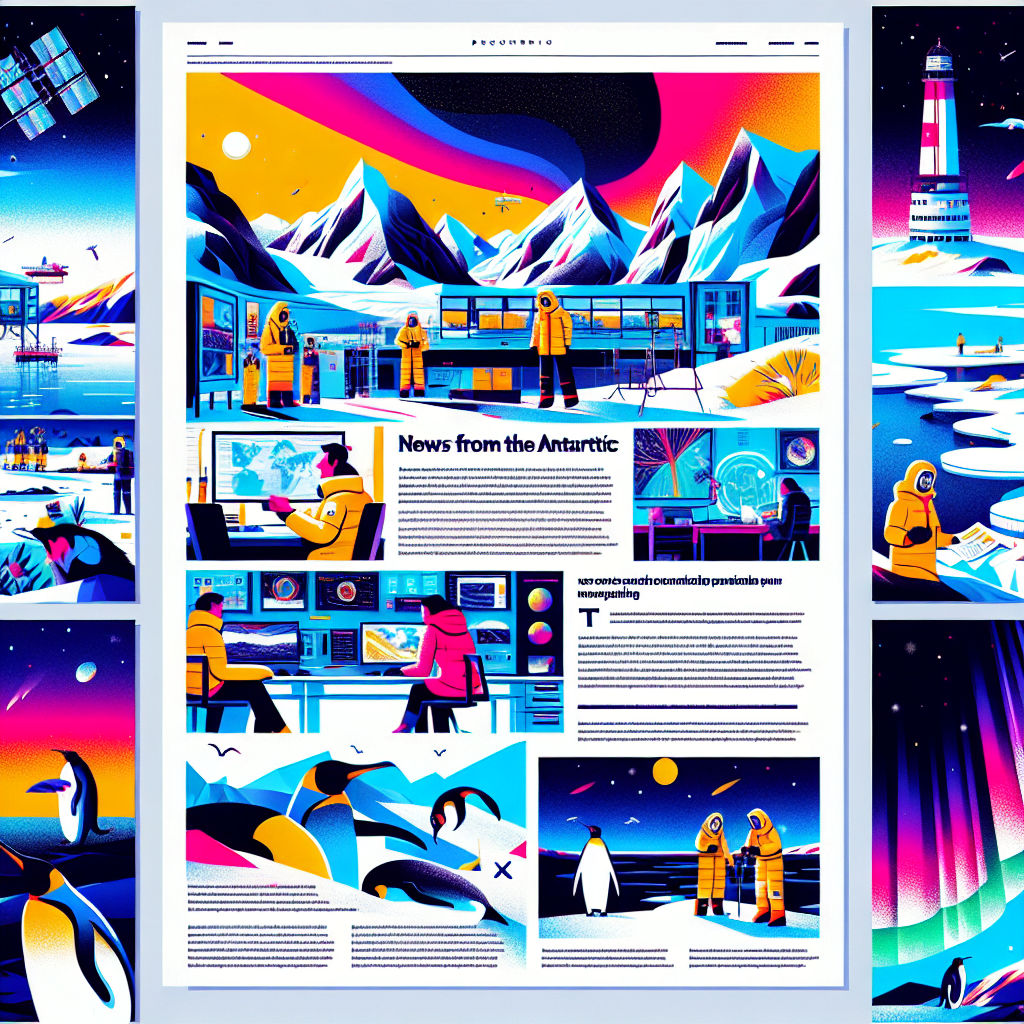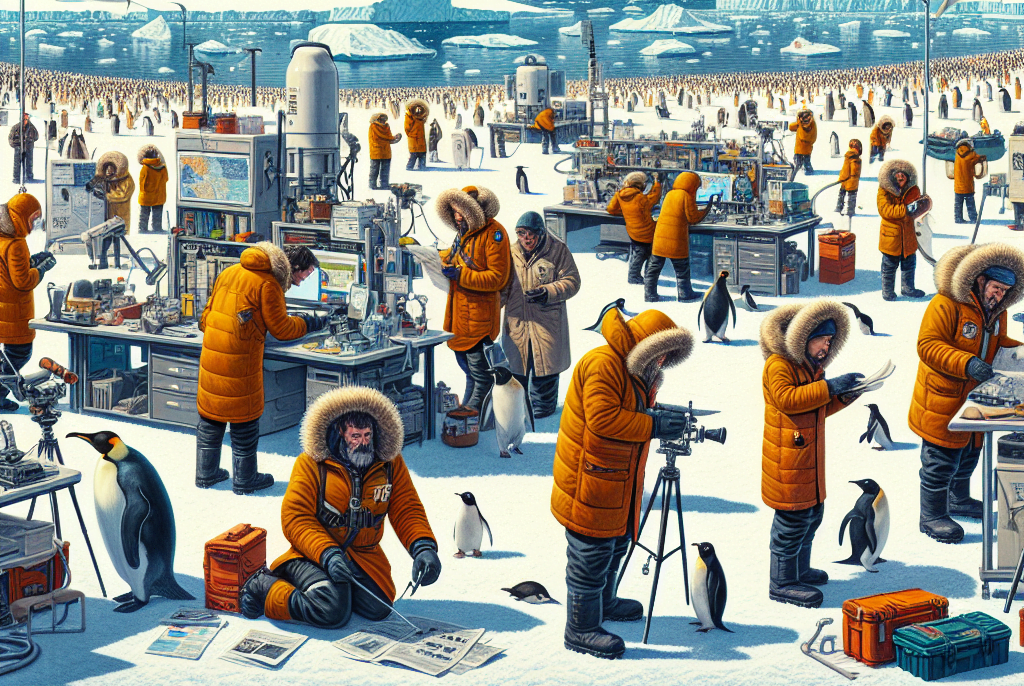Unveiling the Secrets of Antarctic Ice Melt: Latest Findings
The Antarctic, a vast, icy wilderness at the bottom of the world, has long been a subject of fascination and concern for scientists. Its ice sheets, which are up to three miles thick in places, hold vital clues about the Earth’s past climate and, crucially, its future. Recent research has unveiled new secrets about the rate and causes of Antarctic ice melt, providing fresh insights into this complex and urgent issue.
The Antarctic is losing ice at an accelerating rate. Satellite data shows that the continent lost about 2,720 billion metric tons of ice from 1992 to 2017, contributing to a global sea level rise of around 7.6 millimeters. This ice loss is primarily driven by the warming of the surrounding ocean waters, which are melting the ice shelves from below. However, the process is not uniform across the continent. The West Antarctic Ice Sheet is melting much faster than the East Antarctic Ice Sheet, due to differences in geology and ocean currents.
One of the most significant recent findings is the discovery of warm water at a vital point beneath the Thwaites Glacier, a massive and rapidly retreating glacier in West Antarctica. Researchers found that the water at the glacier’s grounding line – the place where the ice meets the ocean – was more than two degrees above freezing point. This warm water is causing the glacier to melt at an alarming rate, potentially leading to a significant rise in global sea levels.
Another important discovery is the role of atmospheric rivers in Antarctic ice melt. Atmospheric rivers are long, narrow regions in the atmosphere that transport water vapor from the tropics to the poles. They are known to cause heavy rainfall and flooding in mid-latitudes, but their impact on the Antarctic was not well understood until recently. Scientists have found that atmospheric rivers are causing significant surface melting in parts of the Antarctic, contributing to ice loss.
These findings have important implications for our understanding of climate change. The Antarctic ice sheet is the largest potential source of future sea level rise. If all the ice in Antarctica were to melt, global sea levels would rise by about 58 meters, inundating coastal cities and displacing millions of people. Understanding the causes and rate of Antarctic ice melt is therefore crucial for predicting and mitigating the impacts of climate change.
However, there is still much we do not know about the Antarctic and its ice. The continent is remote, harsh, and difficult to study. Many of its processes are hidden beneath miles of ice or occur at the microscopic level. Despite these challenges, scientists are making remarkable progress in unveiling the secrets of Antarctic ice melt. They are using innovative techniques, such as drilling deep into the ice to extract ancient air bubbles, deploying underwater robots to explore the ocean beneath the ice shelves, and analyzing satellite data to track changes in ice volume and movement.
In conclusion, the latest findings on Antarctic ice melt highlight the urgency of addressing climate change. They show that the Antarctic is not a distant, unchanging wilderness, but a dynamic and vulnerable part of our planet that is being profoundly affected by human activities. As we continue to unveil the secrets of the Antarctic, we are also uncovering the stark reality of our impact on the Earth’s climate and the urgent need for action.
The Impact of Climate Change on Antarctic Wildlife: A Comprehensive Review

The Antarctic, a vast, icy wilderness at the southernmost part of our planet, is home to a unique array of wildlife that has adapted to survive in its harsh, frigid conditions. However, the survival of these species is increasingly under threat due to the escalating impacts of climate change. This article provides a comprehensive review of the effects of climate change on Antarctic wildlife, highlighting the urgent need for global action to mitigate these impacts.
The Antarctic is warming at an alarming rate, with temperatures rising nearly three times faster than the global average. This rapid warming is causing a significant reduction in sea ice, a critical habitat for many Antarctic species. Sea ice serves as a platform for seals and penguins to rest and breed, and it also supports a rich ecosystem of krill, a primary food source for many Antarctic animals. The loss of sea ice is therefore a significant threat to the survival of these species.
Emperor penguins, the largest of all penguin species, are particularly vulnerable to the loss of sea ice. These birds breed on the ice, and their breeding success is closely tied to the extent and stability of the sea ice. As the ice diminishes, so too does the breeding success of the emperor penguins. Recent studies predict that if the current rate of warming continues, emperor penguin populations could decline by up to 70% by the end of this century.
Seals are also heavily impacted by the loss of sea ice. Many seal species, such as the Weddell seal, rely on the ice for breeding and foraging. As the ice retreats, these seals are forced to travel greater distances to find food, leading to increased energy expenditure and decreased survival rates. Furthermore, the loss of sea ice is also reducing the availability of krill, further exacerbating the challenges faced by these seals.
The impacts of climate change on Antarctic wildlife are not limited to the loss of sea ice. Warming temperatures are also causing changes in the timing and availability of food resources. Many Antarctic species, such as the Adélie penguin, time their breeding to coincide with the peak availability of their food. However, as the climate warms, the timing of these food peaks is shifting, leading to a mismatch between breeding and food availability. This mismatch can result in reduced breeding success and lower survival rates.
In addition to these direct impacts, climate change is also increasing the risk of disease and invasive species in the Antarctic. Warmer temperatures can facilitate the spread of diseases that were previously limited by the cold Antarctic conditions. Similarly, invasive species that were once unable to survive in the Antarctic are now becoming a threat due to the warming climate.
In conclusion, the impacts of climate change on Antarctic wildlife are profound and far-reaching. From the loss of sea ice to changes in food availability, to the increased risk of disease and invasive species, climate change is posing a significant threat to the survival of many Antarctic species. These impacts underscore the urgent need for global action to mitigate climate change and protect the unique and vulnerable wildlife of the Antarctic.
Exploring the Unknown: Recent Scientific Expeditions in the Antarctic
The Antarctic, a vast, icy wilderness at the bottom of the world, has long been a source of fascination and mystery. Its remote location and harsh conditions have made it a challenging destination for explorers and scientists alike. However, recent scientific expeditions have begun to unravel some of the secrets of this enigmatic continent, shedding light on its unique ecosystems, geological history, and potential impacts on global climate change.
One of the most significant recent expeditions to the Antarctic was the British Antarctic Survey (BAS), which has been conducting research in the region for over 60 years. The BAS’s latest mission, which took place in the austral summer of 2019-2020, focused on studying the Thwaites Glacier, a massive and rapidly melting body of ice that has been dubbed the “Doomsday Glacier.” The expedition’s findings have been sobering, revealing that the glacier is melting at an even faster rate than previously thought, which could have serious implications for global sea levels.
In addition to studying the Thwaites Glacier, the BAS expedition also conducted research on the Antarctic’s unique marine life. The team discovered several new species of sea anemones, worms, and crustaceans, highlighting the rich biodiversity of the Antarctic’s waters. These findings underscore the importance of protecting the Antarctic’s fragile ecosystems from the impacts of climate change and human activity.
Meanwhile, a team of scientists from the United States and New Zealand embarked on a different kind of Antarctic expedition. Using a hot-water drill, they bored through over a kilometer of ice to reach the Mercer Subglacial Lake, a body of water that has been isolated from the rest of the world for thousands of years. The team collected water and sediment samples from the lake, which could provide valuable insights into the Antarctic’s past climate conditions and the potential for life in extreme environments.
Another noteworthy expedition was led by a team of Russian scientists, who drilled into the Antarctic’s Lake Vostok, the largest of the continent’s subglacial lakes. The lake, which has been sealed off from the rest of the world for millions of years, could hold clues about the Earth’s ancient climate and the possibility of extraterrestrial life. The team’s preliminary findings suggest that the lake’s waters contain a diverse array of microbial life, a discovery that could have far-reaching implications for our understanding of life’s resilience and adaptability.
These recent expeditions represent just a fraction of the scientific research currently being conducted in the Antarctic. As technology continues to advance, scientists are able to explore this remote continent in ever greater detail, uncovering its secrets and deepening our understanding of our planet. However, these expeditions also highlight the urgent need for action on climate change, as the Antarctic’s rapidly melting ice could have catastrophic consequences for the rest of the world.
In conclusion, the Antarctic remains a frontier of scientific exploration, a place where new discoveries are made and old theories are challenged. The knowledge gained from these expeditions not only enriches our understanding of the natural world but also underscores the importance of preserving this unique and fragile environment for future generations.

